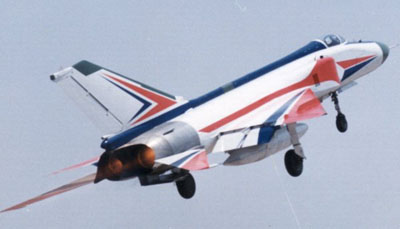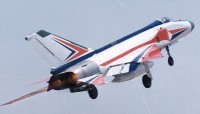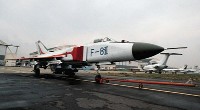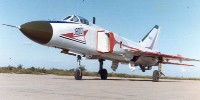Global Aircraft -- J-8 Finback
|
Aviation Center
US Attack
US Bombers
US Cargo
US Fighters
US Helicopters
US Patrol/Pursuit
US Reconnaissance
US Tankers
US Trainers
US UAV's
US X Planes
Orbiter Vehicles
WWI Aircraft
WWII Aircraft
Airbus
Antonov
Boeing
Dassault
Ilyushin
Kamov
MiG
Mil
Saab
Sukhoi
Tupolev
Yakovlev
Joint/Rest of World
Entertainment Center
Members Center
New Technologies
Contact Us
Extra Navigation
GAC Engine
J-8 Finback Specifications
J-8 Finback Features
In order to house a large radar set, the design called for a solid nose and variable geometry side air intakes. However, the lack of familiarity with this type of intake meant the J-8 had to settle for a MiG-21 style nose intake. The solid nose J-8 was finally realized in the J-8II (Finback-B), which was based on the layout of the Soviet Sukhoi Su-15 Flagon-A fighter. The aircraft was originally armed with cannons and seven hardpoints for missiles, bombs, rockets or fuel tanks. Weapons carried include The PL-2, PL-5, and PL-8 short-range air-to-air missiles as well as the PL-11 medium-range radar-guided air-to-air missile. Unguided bombs and rockets can also be carried.
Despite entering service relatively recently, it was comparable to many older Soviet fighter designs, with limited maneuverability. The original combat avionics package was soon replaced with an all-weather capability in aircraft designated J-8I(Finback-A). The gun armament was also changed from two 30-mm cannons to a single 23-mm twin-barreled cannon. The later J-8E featured improved electronic warfare systems. In 1982 work began to replace the unimpressive J-8I type with a new design known as the J-8II. The J-8II series appear quite different from the original J-8, with a new forward fuselage, intakes and nose structure more reminiscent of the F-4 Phantom II or Sukhoi Su-15. J-8IIs are powered by Wopen-13A engines. It was hoped to equip the production J-8B with an American AN/APG-66(V) radar, but this proved politically impossible after the Tiananmen Square protests of 1989. At least 30 J-8Bs have been converted by the PLA Navy to J-8D standard, with an in-flight refuelling probe for use with Xian H-6DU tankers. The J-8IIM, first flown in 1996, is a further improved version. One major improvement over the J-8II is the capable Russian-made Zhuk-8II coherent pulse doppler radar, 100 of which have been delivered in the 1990s. The J-8IIM has had no new orders from China or the export market, where it is offered as the F-8IIM. However the experience gained has been applied by Shenyang Aircraft Company to the later J-8H/F upgrades. The J-8H configuration features WP-13B turbojet engines and the KLJ-1 (Type-1471) Pulse Doppler fire control radar. With the radar upgrade comes the ability to fire the PL-12/SD-10 MRAAM employing an Active Radar Homing (ARH) seeker. The J-8F, featuring a glass cockpit and enhanced air-to-ground capability using the AS-17 'Krypton' anti-radar missile, has also been demonstrated. New build J-8H/Fs have an improved "Type-02" airframe with additional wing fences. The Type-02 is heavier than the original airframe, but can tolerate higher G-loadings. The J-8III/J-8C advanced variant with digital fly-by-wire flight controls was apparently cancelled during the development stage. In 1988, one airframe was converted into the J-8ACT an experimental fly-by-wire testbed for the J-10 program. To date, no plans for a twin-seat J-8 design have been announced.
J-8 Finback Background
The effort to develop an all-weather interceptor began in full in 1964 and this was to result in the first Chinese fighter jet to be designed and built indigenously. The prototype took its maiden flight in 1969. Despite the early beginnings, due to political turmoils such as the Cultural Revolution, it was not produced until 1979 and entered service in 1980. Its basic configuration resembles an enlargement of the delta-wing MiG-21 'Fishbed' with two Liyang (LMC) Wopen-7A turbojet engines and a maximum speed of Mach 2.2. The twin engined J-8 competed with the single engine J-9 project and ultimately emerged as the victor largely due to the existing availability of the former's MiG-21 based powerplant and proven layout.
| ||||||||||||||||||||||||||||||||||||||||||||||




